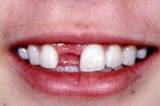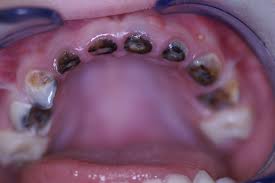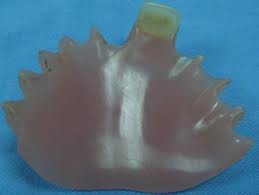Partial dentures are often associated with the elder age group, to replace permanent teeth that have been extracted. However, in some situations children are also required to wear partial dentures.
Reasons for loss of teeth in children:

A child with a missing front tooth
1. High tendency for trauma
Children are highly susceptible to trauma. It has been estimated that 11-30% of children suffer trauma to their milk teeth, which represents about 20% of all injuries in preschool children. 22% suffer trauma to permanent dentition by age 14 years. The peak incident for trauma is at 2-4 years old, then again at 8-10 years, with the upper front teeth being the most commonly involved. The reason for this higher tendency for trauma in children is due to instability as the child has just started to learn walking. Also, in milk teeth, the crown (the part of the tooth visible in the mouth) to root (the part of the tooth that is within the jaw bone) ratio is relatively higher compared to permanent teeth, hence it is easier to get knocked out or avulsed if subjected to trauma.
2. Caries
Children that are not taught to clean their teeth properly naturally end up with badly broken down teeth. The normal dilemma is whether to extract a badly broken down tooth before it is naturally shed off. Instead of extracting it, the patient can opt for root canal therapies or crowns if the condition of the tooth and child permits. An example of a condition with severe destruction of teeth by caries is the “nursing bottle caries“, which is a result of the child sucking on a milk bottle overnight over a long period of time. Milk is broken down into sucrosein the mouth, which is a type of sugar. If the child’s teeth is exposed to this sugar over such a long period of time, the child becomes a victim of rampant caries.
3. Congenitally missing teeth
Some people are born with some missing teeth, for example, children with some conditions such as hypohydrotic ectodermal dysplasia and cleft lip and palate.
When is a partial denture needed in a child?
Milk teeth are usually left to fall out by themselves or extracted only when it is very “wigglyâ€. If they are extracted prematurely, the succedaneous permanent teeth may drift forward into the empty space and cause lack of eruption space for the other teeth, which then leads to crooked teeth and orthodontic problems. On the other hand, if a milk tooth is highly decayed and is causing the child pain or distress, the infection can spread and worsen the condition. In this case, the tooth or teeth should be extracted. To preserve the space preciously occupied by the milk tooth to avoid orthodontic problems, a partial denture should be given.
Partial dentures are also given to aid the child in eating and talking, especially if multiple teeth are missing. Aesthetics is another reason partial dentures are needed in children, especially if the front teeth is lost.
What is the difference between partial dentures for adults and children?
- Partial dentures for children are usually used to replace missing milk teeth until their succeeding teeth have come out, while those for adults are to replace missing permanent teeth.
- Partial dentures for children are a temporary measure, and are worn only until the succedaneous permanent teeth have erupted.
- Being a temporary denture, they have simpler designs.
- They are usually made of pink acrylic to allow for easy adjustment and replacement, instead of metal (chrome cobalt) as in adult dentures.
Why can’t a partial denture for children be used as a permanent denture?
Children are still growing, and further growth and tooth eruption is anticipated, so the denture will not be able to fit once such changes occur.
 Types of partial dentures:
1. Removable partial dentures
One example is the “spoon denture”. It is especially useful to replace a missing front tooth and serves primarily to restore the child’s appearance.
Problems with removable partial denture:
- a child has little tolerance towards having something inserted in the mouth over a long period of time and often will not wear it.
- a child can easily lose the denture.
- It is more bulky compared to a fixed prosthesis.
2. Fixed partial dentures
Rather than a “partial dentureâ€, it serves more like a space maintainer. For example, a crown or a metal band is placed on the tooth (usually a molar) adjacent to the missing tooth, and a metal wire is bent and soldered to the band or crown to prevent any teeth from drifting into the empty space. If an artificial tooth is used to replace the missing tooth, it is called a “functional space maintainerâ€, while if no artificial tooth is used, it is called “non-functional space maintainerâ€.
Â


With havin so much written content do you ever run into any issues of plagorism or copyright infringement? My blog has a lot of unique content I’ve either written myself or outsourced but it seems a lot of it is popping it up all over the web without my agreement. Do you know any ways to help stop content from being ripped off? I’d definitely appreciate it.
Hi, I do not write many articles online, but I know what u mean, i’ve searched for one thing and seen whole paragraphs, copied word for word, on different websites. No, i do not know how to stop that, but if anyone does, i’d like to know as well:)